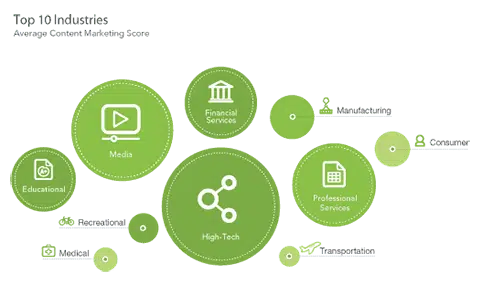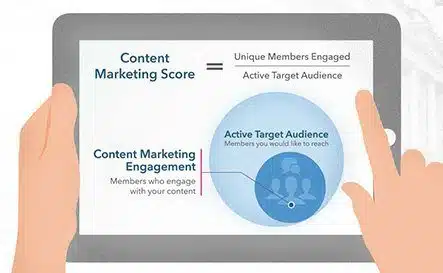LinkedIn crossed 500 million users earlier this year. With 10+ million active jobs, access to 9+ million companies and with over 1,00,000 articles published every week LinkedIn has built a professional community that never existed before. Brands which distribute content on the platform have to rely on ‘LinkedIn Content Marketing Score’ metric to measure engagement.
LinkedIn Content Marketing Score is a recommendation engine that measures the impact by evaluating how your audience engages with your content. The metric also benchmarks your performance against your competitors.
CMS also shares a breakdown of how your content’s performance across the platform including Company Updates, Sponsored Updates, Groups, Influencer Posts and more. The average content marketing score varies based on the type of the industry and size of your company.
How LinkedIn Content Marketing Score Works?
LinkedIn Content Marketing Score provides you insight into the impact of both your paid and organic content on the platform. LinkedIn calculates the score by measuring unique engagement (gauged through social actions), divided by your total target audience. Social actions include likes, shares, comments, and clicks on the content published.
Content Marketing Score measures how followers engage with your Sponsored Content, Company Pages, LinkedIn Groups, employee updates, and Influencer posts (if applicable). LinkedIn assigns your brand a single score, ranked against your competitive set. Your brand will also receive recommendations on how to improve your score based on different parameters you can pull to deliver more reach, frequency, and engagement. Brands can filter their score by region, seniority, company size, job function, and industry.
What LinkedIn won’t tell you about LinkedIn Content Marketing Score?
Recommendation Engine, not a ranking system
CMS is a recommendation engine, not a ranking system. As a brand it allows you to analyze how different content types perform on LinkedIn and also check how different organic and paid activities are contributing. Content Marketing Score has been designed to enable brands to drive reach and engagement.
For instance, brands can leverage trending content tool to gather insights on how specific topics resonate with different audiences and top performing content on each of them. The insights gathered can be leveraged to refine the content strategy.
Finding your ‘Big Rock.’
To maximize value from any piece of content you need to identify your strategies ‘Big Rock’. ‘Big Rock’ is about finding the subject your audience cares about most and the questions they want to be answered. Once you have identified topics that your audience cares about, you need to produce the definitive pieces of content on those issues.
After you have gained authority by putting your ‘Big Rock’ in place, you have to start creating content that provides your unique perspectives by focusing on different types of values. You need to use different forms of storytelling to bring the inherent truths that you’ve established to life.
Always-on Strategy
Your audience needs to be exposed to content multiple times before they start engaging with your content. Brands that engage actively with their audience use an always-on strategy to build recall and relevance.
To unlock the potential of your content, you need to start by investing in promoting and amplifying it in a locally relevant way. To feed different audience segments you can use a combination of Direct Sponsored Content, and language-preference targeting to post different versions of content to the feed.
LinkedIn Benchmark’s Lie
A study conducted by Forrester found that LinkedIn has an average engagement rate of (0.54%) (which is higher compared to Twitter (0.3%). LinkedIn’s own benchmark engagement rate is (0.4%). Forrester analyzed engagement rates of top 50 global brands to arrive at the figure. (Engagement rate measures user’s interactions with a brands’ posts as a percentage of a brands’ followers).
LinkedIn benchmark rates are very conservative, and with the right content strategy in place, you will find that your engagement rates are always 2X the LinkedIn benchmark rates. LinkedIn doesn’t share a benchmark Content Marketing Score but even if it did it wouldn’t be relevant for your brand.
- B2B companies typically perform better than B2C companies on LinkedIn.
- Content Marketing Score varies based on industry, size of the company and number of followers.
- CMS is not relevant if you are not reaching out to the right audience.
Social Advocacy
Social advocacy drives reach and engagement by involving employees in sharing and amplifying content. Content shared by employees has 2x higher click-through rates compared to company shares of the same content. LinkedIn launched Elevate, an employee advocacy solution to help brands to maximize the impact of their programs. Social advocacy has been an essential component for brands in improving LinkedIn Content Marketing Score.
An essential aspect of content marketing is knowing what to talk about, with CMS you have visibility on what works for your brand. Beyond the numbers, the broader idea of CMS is to help brands to maximize the impact of their content.



